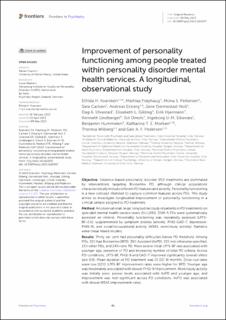| dc.contributor.author | Kvarstein, Elfrida Hartveit | |
| dc.contributor.author | Frøyhaug, Mathias | |
| dc.contributor.author | Skjeklesæther-Pettersen, Mona | |
| dc.contributor.author | Carlsen, Sara | |
| dc.contributor.author | Ekberg, Andreas | |
| dc.contributor.author | Fjermestad-Noll, Jane | |
| dc.contributor.author | Ulvestad, Dag Anders | |
| dc.contributor.author | Gikling, Elisabeth | |
| dc.contributor.author | Hjermann, Eirik | |
| dc.contributor.author | Lindberget, Kenneth | |
| dc.contributor.author | Omvik, Siri | |
| dc.contributor.author | Eikenæs, Ingeborg Helene Ulltveit-Moe | |
| dc.contributor.author | Hummelen, Benjamin | |
| dc.contributor.author | Morken, Katharina Teresa Enehaug | |
| dc.contributor.author | Wilberg, Theresa | |
| dc.contributor.author | Pedersen, Geir Arild Feigum | |
| dc.date.accessioned | 2023-08-09T09:04:43Z | |
| dc.date.available | 2023-08-09T09:04:43Z | |
| dc.date.created | 2023-06-02T10:56:27Z | |
| dc.date.issued | 2023-05-09 | |
| dc.identifier.issn | 1664-0640 | |
| dc.identifier.uri | https://hdl.handle.net/11250/3083170 | |
| dc.description.abstract | Objective: Evidence-based personality disorder (PD) treatments are dominated by interventions targeting Borderline PD, although clinical populations characteristically include different PD features and severity. Personality functioning is a new concept intended to capture common features across PDs. This study aimed to investigate longitudinal improvement of personality functioning in a clinical sample assigned to PD treatment.
Method: An observational, large, longitudinal study of patients in PD treatments on specialist mental health service levels (N = 1,051). DSM-5 PDs were systematically assessed on referral. Personality functioning was repeatedly assessed (LPFS-BF-2.0), supplemented by symptom distress (anxiety: PHQ-GAD-7, depression: PHQ-9), and social/occupational activity (WSAS, work/study activity). Statistics were linear mixed models.
Results: Thirty per cent had personality difficulties below PD threshold. Among PDs, 31% had Borderline (BPD), 39% Avoidant (AvPD), 15% not otherwise specified, 15% other PDs, and 24% > one PD. More severe initial LPFS-BF was associated with younger age, presence of PD and increasing number of total PD criteria. Across PD conditions, LPFS-BF, PHQ-9 and GAD-7 improved significantly (overall effect size 0.9). Mean duration of PD treatment was 15 (SD 9) months. Drop-out rates were low (12%). LPFS-BF improvement-rates were higher for BPD. Younger age was moderately associated with slower PHQ-9 improvement. Work/study activity was initially poor, poorer levels associated with AvPD and younger age, and improvement was non-significant across PD conditions. AvPD was associated with slower WSAS improvement-rates.
Conclusion: Personality functioning improved across PD conditions. The results highlight BPD improvements. The study points to challenges concerning AvPD treatment, poor occupational activity and age-related differences. | en_US |
| dc.language.iso | eng | en_US |
| dc.publisher | Frontiers | en_US |
| dc.rights | Navngivelse 4.0 Internasjonal | * |
| dc.rights.uri | http://creativecommons.org/licenses/by/4.0/deed.no | * |
| dc.title | Improvement of personality functioning among people treated within personality disorder mental health services. A longitudinal, observational study | en_US |
| dc.type | Journal article | en_US |
| dc.type | Peer reviewed | en_US |
| dc.description.version | publishedVersion | en_US |
| dc.rights.holder | Copyright 2023 the authors | en_US |
| dc.source.articlenumber | 1163347 | en_US |
| cristin.ispublished | true | |
| cristin.fulltext | original | |
| cristin.qualitycode | 1 | |
| dc.identifier.doi | 10.3389/fpsyt.2023.1163347 | |
| dc.identifier.cristin | 2151127 | |
| dc.source.journal | Frontiers in Psychiatry | en_US |
| dc.identifier.citation | Frontiers in Psychiatry. 2023, 14, 1163347. | en_US |
| dc.source.volume | 14 | en_US |

